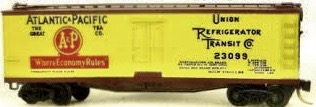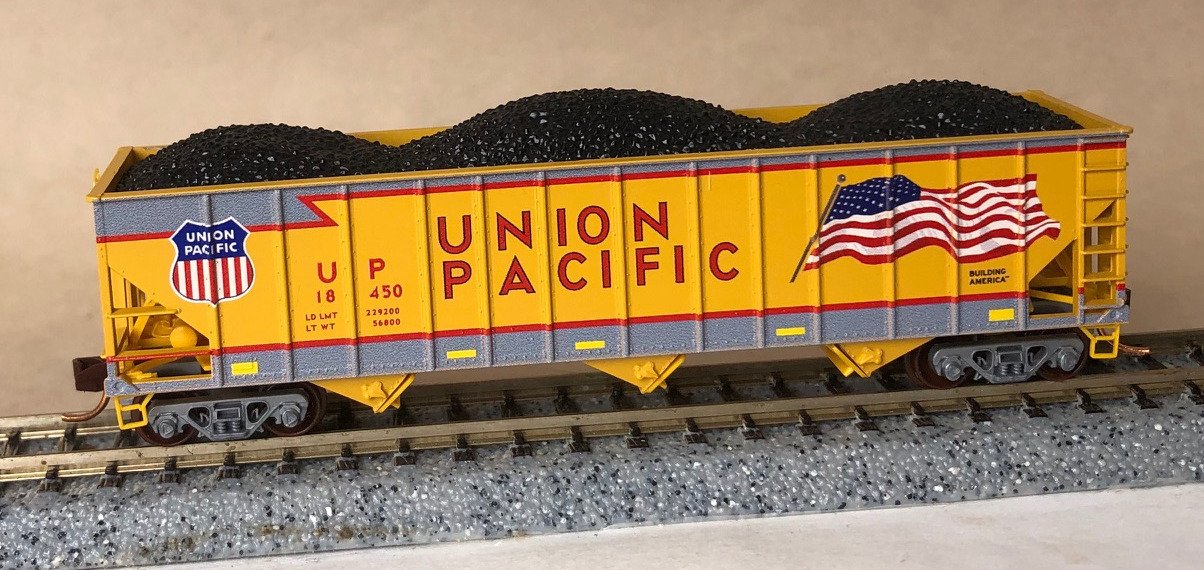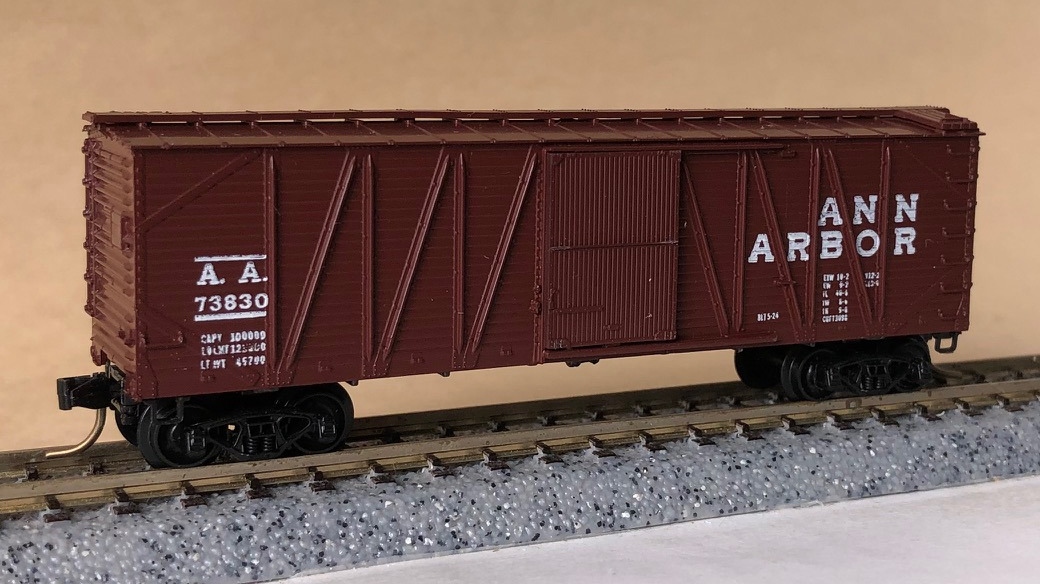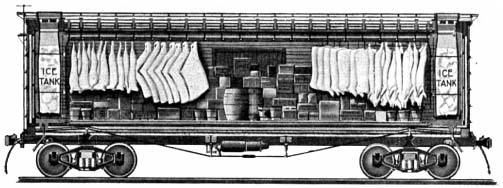Micro-Trains - 47010 - Reefer, 40 Foot, Wood Sheathed - Atlantic & Pacific (Food) - 23099
Click to see the details
market
Click to see the details
history
Click to see the details
collector
| Stock Number | 47010 |
| Secondary Stock Number | 047 00 010 |
| Original Retail Price | $4.50 |
| Brand | Micro-Trains |
| Manufacturer | Kadee Quality Products |
| Body Style | Micro-Trains 047 Reefer Wood Sheathed 40 Foot Horizontal Brake |
| Prototype Vehicle | Reefer, Ice, Wood (Details) |
| Prototype | Reefer, 40 Foot, Wood Sheathed |
| Road or Company Name | Atlantic & Pacific (Food) (Details) |
| Reporting Marks | URTC |
| Road or Reporting Number | 23099 |
| Paint Color(s) | Yellow with a dark brown roof and ends |
| Print Color(s) | Red & Black |
| Coupler Type | MT Magne-Matic Knuckle |
| Coupler Mount | Truck-Mount |
| Wheel Type | Plastic Wheels With Steel Axle |
| Release Date | 1976-09-01 |
| Item Category | Rolling Stock (Freight) |
| Model Type | Reefer |
| Model Subtype | 40 Foot |
| Model Variety | Wood Sheathed, Horizontal Brake Wheel |
| Prototype Region | North America |
| Prototype Era | NA Era II: Late Steam (1901 - 1938) |
| Scale | 1/160 |
Model Information:
Horizontal Brake Wheel is equivalent to Side-Mounted Brake Wheel. The wheel itself is vertical.
Prototype History:
During the mid-19th century, attempts were made to ship agricultural products by rail. As early as 1842, the Western Railroad of Massachusetts was reported in the June 15 edition of the Boston Traveler to be experimenting with innovative freight car designs capable of carrying all types of perishable goods without spoilage. The first refrigerated boxcar entered service in June 1851, on the Northern Railroad (New York) (or NRNY, which later became part of the Rutland Railroad). This "icebox on wheels" was a limited success since it was only functional in cold weather. That same year, the Ogdensburg and Lake Champlain Railroad (O&LC) began shipping butter to Boston in purpose-built freight cars, utilizing ice for cooling.
The first consignment of dressed beef left the Chicago stock yards in 1857 in ordinary boxcars retrofitted with bins filled with ice. Placing meat directly against ice resulted in discoloration and affected the taste, proving to be impractical. During the same period Swift experimented by moving cut meat using a string of ten boxcars with their doors removed, and made a few test shipments to New York during the winter months over the Grand Trunk Railway (GTR). The method proved too limited to be practical.
The use of ice to refrigerate and preserve food dates back to prehistoric times. Through the ages, the seasonal harvesting of snow and ice was a regular practice of many cultures. China, Greece, and Rome stored ice and snow in caves, dugouts or ice houses lined with straw or other insulating materials. Rationing of the ice allowed the preservation of foods during hot periods, a practice that was successfully employed for centuries. For most of the 19th century, natural ice (harvested from ponds and lakes) was used to supply refrigerator cars. At high altitudes or northern latitudes, one foot tanks were often filled with water and allowed to freeze. Ice was typically cut into blocks during the winter and stored in insulated warehouses for later use, with sawdust and hay packed around the ice blocks to provide additional insulation. A late-19th century wood-bodied reefer required re-icing every 250 miles (400 km) to 400 miles (640 km).
From Wikipedia
The first consignment of dressed beef left the Chicago stock yards in 1857 in ordinary boxcars retrofitted with bins filled with ice. Placing meat directly against ice resulted in discoloration and affected the taste, proving to be impractical. During the same period Swift experimented by moving cut meat using a string of ten boxcars with their doors removed, and made a few test shipments to New York during the winter months over the Grand Trunk Railway (GTR). The method proved too limited to be practical.
The use of ice to refrigerate and preserve food dates back to prehistoric times. Through the ages, the seasonal harvesting of snow and ice was a regular practice of many cultures. China, Greece, and Rome stored ice and snow in caves, dugouts or ice houses lined with straw or other insulating materials. Rationing of the ice allowed the preservation of foods during hot periods, a practice that was successfully employed for centuries. For most of the 19th century, natural ice (harvested from ponds and lakes) was used to supply refrigerator cars. At high altitudes or northern latitudes, one foot tanks were often filled with water and allowed to freeze. Ice was typically cut into blocks during the winter and stored in insulated warehouses for later use, with sawdust and hay packed around the ice blocks to provide additional insulation. A late-19th century wood-bodied reefer required re-icing every 250 miles (400 km) to 400 miles (640 km).
From Wikipedia
Road Name History:
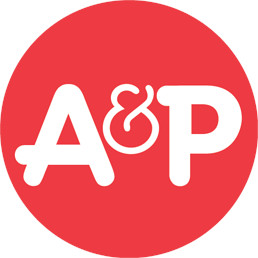 The Great Atlantic & Pacific Tea Company, better known as A&P, was an American and Canadian chain of grocery stores that ceased supermarket operations in November 2015, after 156 years in business. From 1915 through 1975, A&P was the largest food/grocery retailer in the United States (until 1965, the largest U.S. retailer of any kind). A&P was considered an American icon that according to The Wall Street Journal "was as well known as McDonald's or Google is today" and that A&P was "Walmart before Walmart." Known for innovation, A&P and the supermarkets that followed its lead significantly improved nutritional habits by making available a vast assortment of food products at much lower costs. Until 1982, A&P also was a large food manufacturer. In his 1952 book, American Capitalism, John Kenneth Galbraith cited A&P's manufacturing strategy as a classic example of countervailing power that was a welcome alternative to state price controls.
The Great Atlantic & Pacific Tea Company, better known as A&P, was an American and Canadian chain of grocery stores that ceased supermarket operations in November 2015, after 156 years in business. From 1915 through 1975, A&P was the largest food/grocery retailer in the United States (until 1965, the largest U.S. retailer of any kind). A&P was considered an American icon that according to The Wall Street Journal "was as well known as McDonald's or Google is today" and that A&P was "Walmart before Walmart." Known for innovation, A&P and the supermarkets that followed its lead significantly improved nutritional habits by making available a vast assortment of food products at much lower costs. Until 1982, A&P also was a large food manufacturer. In his 1952 book, American Capitalism, John Kenneth Galbraith cited A&P's manufacturing strategy as a classic example of countervailing power that was a welcome alternative to state price controls.
In 1859, the Great Atlantic & Pacific Tea Company, known everywhere as A&P, began as a mail-order business located at 31 Vesey Street in downtown Manhattan. In 1936, A&P became the first national supermarket chain in the United States The company experienced financial and filed for Chapter 11 protection in 2010. March 13, 2012 it was announced that A&P had emerged from bankruptcy and was now a private company.

In 1859, the Great Atlantic & Pacific Tea Company, known everywhere as A&P, began as a mail-order business located at 31 Vesey Street in downtown Manhattan. In 1936, A&P became the first national supermarket chain in the United States The company experienced financial and filed for Chapter 11 protection in 2010. March 13, 2012 it was announced that A&P had emerged from bankruptcy and was now a private company.
Brand/Importer Information:
Micro-Trains is the brand name used by both Kadee Quality Products and Micro-Trains Line. For a history of the relationship between the brand and the two companies, please consult our Micro-Trains Collector's Guide.
Manufacturer Information:
 Kadee Quality Products originally got involved in N-Scale by producing a scaled-down version of their successful HO Magne-Matic knuckle coupler system. This coupler was superior to the ubiquitous 'Rapido' style coupler due to two primary factors: superior realistic appearance and the ability to automatically uncouple when stopped over a magnet embedded in a section of track. The success of these couplers in N-Scale quickly translated to the production of trucks, wheels and in 1972 a release of ready-to-run box cars.
Kadee Quality Products originally got involved in N-Scale by producing a scaled-down version of their successful HO Magne-Matic knuckle coupler system. This coupler was superior to the ubiquitous 'Rapido' style coupler due to two primary factors: superior realistic appearance and the ability to automatically uncouple when stopped over a magnet embedded in a section of track. The success of these couplers in N-Scale quickly translated to the production of trucks, wheels and in 1972 a release of ready-to-run box cars.
In October 1990 Kadee separated in two companies, with the newly created Micro-Trains® Line Co. continuing the Z, Nn3, and N Scale product ranges, with Kadee retaining the HO range.

In October 1990 Kadee separated in two companies, with the newly created Micro-Trains® Line Co. continuing the Z, Nn3, and N Scale product ranges, with Kadee retaining the HO range.
Item created by: nscalemodeler160
on 2016-04-05 02:18:48
Last edited by: Alain LM on 2022-05-10 12:08:33
If you see errors or missing data in this entry, please feel free to log in and edit it. Anyone with a Gmail account can log in instantly.
Last edited by: Alain LM on 2022-05-10 12:08:33
If you see errors or missing data in this entry, please feel free to log in and edit it. Anyone with a Gmail account can log in instantly.


